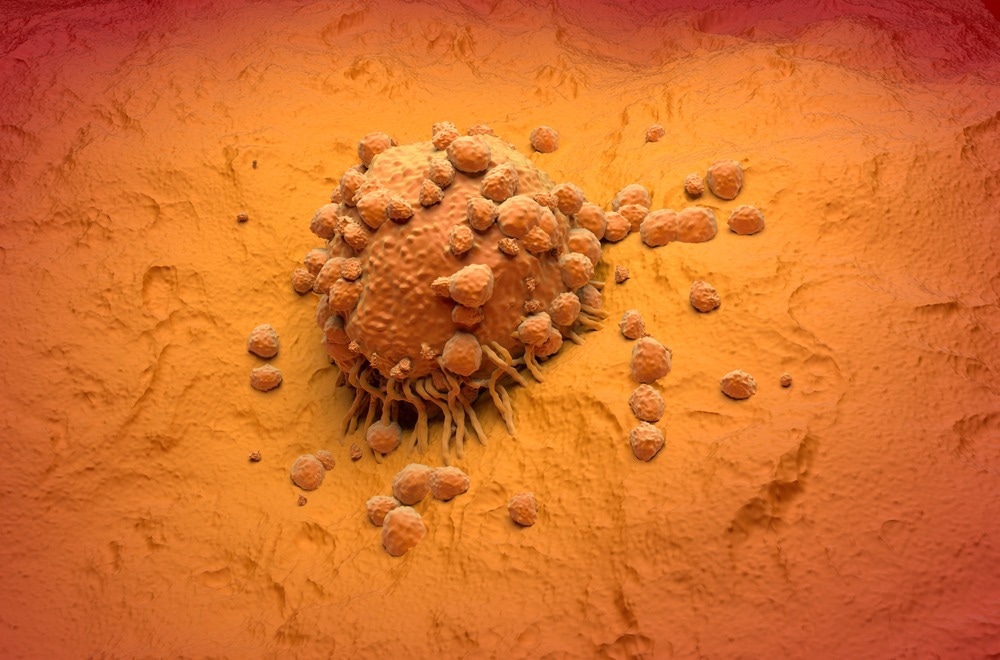In a recent study published in Nature Cell Biology, a team of researchers discovered that the elevated expression of lamin-associated polypeptide 1 (LAP1), an inner nuclear membrane protein, helps metastatic melanoma cells surmount the physical challenges presented by tissue structure and the microenvironment during metastasis.
 Study: LAP1 supports nuclear adaptability during constrained melanoma cell migration and invasion. Image Credit: Nemes Laszlo/Shutterstock
Study: LAP1 supports nuclear adaptability during constrained melanoma cell migration and invasion. Image Credit: Nemes Laszlo/Shutterstock
Background
Metastasis, the migration of cancer cells from the site of the primary tumor and colonization of tissues in other body regions, is one of the primary causes of cancer-related mortality. Melanoma cells metastasize as individual cells or collectively and can carry out tumor microenvironment reprogramming and extracellular matrix degradation to promote cancer cell migration and invasion of tissue.
Negotiating through the vascular endothelium and constrictions in the tissue is a major challenge for metastatic cells, especially for the nucleus, since the cytoplasm can tolerate substantial deformation. The nuclear envelope proteins, cytoskeleton, nuclear lamina, and chromatin regulate the physical properties of the organelle.
Tension or compression of the nuclear envelope can cause disruption of the heterochromatic structure and the nuclear lamina, rupturing the nuclear envelope and exposing the genomic deoxyribonucleic acid (DNA) to degradation by cytoplasmic chemicals.
Understanding how the cytoskeletal components of the nuclear envelope facilitate the formation of a nuclear envelope bleb, similar to a cytoplasmic bleb, might elucidate the mechanisms through which cancer cells overcome the physical constraints and mechanical stress during metastasis.
About the study
In the present study, the researchers obtained a pair of melanoma cells lines from the same patient, one from a primary tumor (WM983A) and the other from a metastatic tumor (WM983B), that stably expressed green-fluorescent protein localized in the nucleus (GFP-NLS). These cell lines were used for a series of muti-round transwell migration assays that involved subnuclear diameter pores.
The elevated Rho-associated kinases (ROCK1/2)-driven myosin II (MLC2) activity observed in metastatic cell line WM938B was confirmed using further transwell migration assays involving GSK269962A, a ROCK1/2 inhibitor. The dynamic character of the nuclear envelope of the metastatic cell line was corroborated using a secondary pair of melanoma cell lines — A375M2, which are highly metastatic and ameboid, and A375P, which are less ameboid and metastatic.
Additionally, the transcriptomes of the A375M and A375P cell lines were compared for nuclear protein-encoding genes using gene set enrichment analysis. The Philadelphia and Mannheim datasets, which are publicly available and contain comparisons of the transcriptomic profiles of melanocytes and melanoma cell lines, were used to analyze the expression of the nuclear protein-encoding genes. Publicly available datasets of patients were also used to determine elevated messenger ribonucleic acid (mRNA) levels in metastatic melanoma samples.
Additional two-round transwell migration assays involving a loss-of-function approach were used to understand the role of LAP1 in the enhanced migration ability of metastatic cells and nuclear envelope blebbing. Using different translation initiation codons, human cells produce two LAP1 isoforms that differ in the amino acid terminus length. A solubilization assay was used to determine if the two isoforms differ in the roles they play in nuclear envelope blebbing.
Furthermore, WM983A cells expressing both isoforms and GFP-NLS were used to determine the roles of the two isoforms in the migration of metastatic cells and tissue invasion. The functions of the two isoforms in the tethering of the nuclear envelope to the nuclear lamina and interactions with Torsin-1A, an AAA-family adenosine triphosphatase (ATPase) found in the lumina of the endoplasmic reticulum, were also examined.
Results
The results reported that metastatic melanoma cells have an elevated expression of LAP1, and of the two isoforms of LAP1, LAP1C, which has a shorter amino acid terminus region compared to LAP1B, forms a weaker coupling between the nuclear lamina and the nuclear envelope, enabling nuclear envelope blebbing, and migration and invasion by metastatic cells.
In contrast, the expression of LAP1B could not improve nuclear envelope bleb formation unless either its Torsin-1A activation ability or the strong lamin-binding domain on its amino acid terminal were removed. LAP1B showed a preference for the less-deformable Lamin B, which suggested that LAP1C, with its weaker association between the nuclear lamina and nuclear envelope, might be recruited to nuclear envelope for bleb formation or to blebs that are structurally compromised, allowing the nuclear membrane to be released from the chromatic and expand.
Conclusions
Overall, the results reported that the fine-tuned expression and recruitment of the LAP1C isoform by metastatic cells during nuclear envelope blebbing might play a major role in surmounting the physical constraints of migration and invasion during metastasis.
The authors believe that LAP1 could be used as a prognostic marker for determining the metastatic nature of melanomas, and further research on LAP1 function could help in the development of methods to prevent the metastatic spread of cancers.